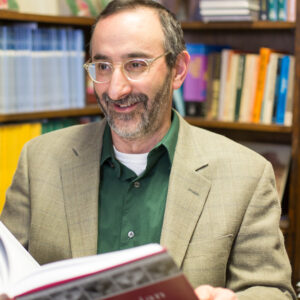
Charting a Way Back
Apr 12, 2024 By Ayelet Cohen | Commentary | Tazria
The book of Vayikra can be understood as an exercise in transition; if one imagines the Torah as the lifecycle trajectory of Israel, this The book of Vayikra can be understood as an exercise in transition; if one imagines the Torah as the lifecycle trajectory of Israel, this book represents adolescence/early adulthood. The Israelites are still transitioning from being an enslaved people toward becoming a free people. With their newfound autonomy, they must learn responsibility to one another and service to God. They struggle with faith, patience, ethical behavior, interpersonal relationships, and boundaries—in short, all of the things that are hard about maturation and adulthood. book represents adolescence/early adulthood. The Israelites are still transitioning from being an enslaved people toward becoming a free people. With their newfound autonomy, they must learn responsibility to one another and service to God. They struggle with faith, patience, ethical behavior, interpersonal relationships, and boundaries—in short, all of the things that are hard about maturation and adulthood.
Read More
It Passes and We Stay
Apr 21, 2023 By Jan Uhrbach | Commentary | Metzora | Shabbat Rosh Hodesh | Tazria
The double parashiyot of Tazria and Metzora are devoted in their entireties to the Biblical notion of tumah, usually translated as “impurity.” In them, we learn three of the major sources of tumah: childbirth (Lev. 12); a condition known as tzara’at, which can manifest on skin, clothing, or the walls of one’s house (Lev. 13–14); and bodily secretions (Lev. 15). The two other primary sources of tumah are touching or carrying the carcasses of certain animals (Lev. 11) and contact with a human corpse (Num. 19).
But what is the essential nature of tumah, and what does it have to do with Emily Dickinson’s poem?
Read More
Here I Am, Tzara’at and All
Apr 1, 2022 By Rachel Rosenthal | Commentary | Shabbat Hahodesh | Tazria
When I was 12, a few weeks before my bat mitzvah I went in to meet with one of the rabbis of my synagogue. At the time, the synagogue newsletter included a “pasuk of the week,” a verse from that week’s Torah portion that was particularly interesting or thought provoking. However, as the rabbi confessed to […]
Read More
The Values of a Jewish Home
Apr 16, 2021 By Matthew Berkowitz | Commentary | Metzora | Tazria | Yom Hazikaron-Yom Ha'atzma'ut
In the precious days “Before the Coronavirus Era” (B.C.E.), the parshiyot of Tazria-Metzora seemed wholly disconnected from our lives, presenting the perennial challenge of relevance (or irrelevance) to even the most talented darshan (sermonizer). How are we to connect leprous plagues attacking both body and abode to our daily lives? And to what extent does the experience of quarantine resonate with our modern reality? These are only two of the many questions that we would have posed in a pre-Covid world.
Living Outside the Camp
Apr 24, 2020 By | Commentary | Metzora | Tazria
For many of us, the Torah portions of Tazria and Metzora have never felt so relevant. While in years past there was a great sense of distance from the confusing descriptions of biblical skin afflictions, the quarantine of afflicted Israelites, and the complex post-illness purification process, it feels difficult to escape their prescience during our current global pandemic. As we all struggle with the challenges of social distancing and the uncertainty of the future, I believe that insights into the details of our parshiyot can provide us with points of reflection for our present reality.
Read More
How to Approach God
Apr 5, 2019 By Benjamin D. Sommer | Commentary | Tazria
There are probably no Torah readings as widely misunderstood as the Torah readings for this week and next week, Parashat Tazria and Parashat Metzora. These parshiyot are devoted entirely to the subject of ritual purity. They discuss what causes people to become ritually impure, how they can become ritually pure again, and what the effects of this state are. For many modern readers, this topic is off-putting. It seems primitive and far removed from the real concerns of an ethical and monotheistic religion.
And yet to the authors of the Bible, these laws were of paramount importance. They were seamlessly intertwined with the idea of monotheism.
Read More
It Passes and We Stay
Apr 20, 2018 By Jan Uhrbach | Commentary | Metzora | Tazria
A Light exists in Spring
Not present on the Year
At any other period—
When March is scarcely here
The double parashiyot of Tazria and Metzora are devoted in their entireties to the Biblical notion of tumah, usually translated as “impurity.” In them, we learn three of the major sources of tumah: childbirth (Lev. 12); a condition known as tzara’at, which can manifest on skin, clothing, or the walls of one’s house (Lev. 13–14); and bodily secretions (Lev. 15). The two other primary sources of tumah are touching or carrying the carcasses of certain animals (Lev. 11) and contact with a human corpse (Num. 19).
Read More
Guarding Our Tongues
Apr 28, 2017 By Abigail Uhrman | Commentary | Metzora | Tazria
Becoming is better than being.
—Carol Dweck, Mindset: The New Psychology of Success
This week’s parashah discusses tzara’at, a skin disease understood in rabbinic tradition as punishment for lashon hara, evil speech. The public castigation that the metzora suffers is a powerful warning for us to “guard our tongues.” It was with words that God created the world, and our words have potential to build, create, and sustain life and human dignity, or to be a source of pain and destruction.
Read More


